Abstract
Background:
Oral health has an impact on quality of life hence for research purpose validation of a Tamil version of General Oral Health Assessment Index would enable it to be used as a valuable tool among Tamil speaking population.
Aim:
In this study, we aimed to assess the psychometric properties of translated Tamil version of General Oral Health Assessment Index (GOHAI-Tml).
Subjects and Methods:
Linguistic adaptation involved forward and backward blind translation process. Reliability was analyzed using test-retest, Cronbach alpha, and split half reliability. Inter-item and item-total correlation were evaluated using Spearman rank correlation. Convenience sampling was done, and 265 consecutive patients aged 20–70 years attending the outpatient department were recruited. Subjects were requested to fill a self-reporting questionnaire along with Tamil GOHAI version. Clinical examination was done on the same visit. Concurrent validity was measured by assessing the relationship between GOHAI scores and self-perceived oral health and general health status, satisfaction with oral health, need for dental treatment and esthetic satisfaction. Discriminant validity was evaluated by comparing the GOHAI scores with the objectively assessed clinical parameters. Exploratory factor analysis was done to examine the factor structure.
Results:
Mean GOHAI-Tml was 52.7 (6.8, range 22–60, median 54). The mean number of negative impacts was 2 (2.4, range 0–11, median 1). The Spearman rank correlation for test-retest ranged from 0.8 to 0.9 (P < 0.001) for all the 12 items between visits. The Cronbach alpha for 265 samples was 0.8 suggesting good internal consistency and homogeneity between items. Item scale correlation ranged from 0.4 to 0.8 (P < 0.001). Concurrent and discriminant validity was established. Principal component analysis resulted in extraction of four factors which together accounted for 66.4% (7.9/12) variance.
Conclusion:
GOHAI-Tml has shown acceptable psychometric properties, so that it can be used as an efficient tool in identifying the impact of oral health on quality of life among the Tamil speaking population.
Keywords: General oral health assessment index, Linguistic adaptation, Oral health-related quality of life, Psychometric properties, Reliability, Validity
Introduction
The Quality of Life (QOL) refers to the degree to which a person enjoys the important possibilities of life. Oral health affects a person physically and psychologically thereby affecting QOL.[1] The conceptual framework for measuring Oral Health-Related QOL (OHRQOL) was described by Locker and is based on WHO classification of impairment, disability and handicap and attempts to comprehend all possible functional and psychosocial outcomes of oral disorders.[2]
OHRQOL is a subjective indicator measuring nonclinical aspects of oral health that patients feel more relevant to their overall health and well-being. It quantifies the extent to which dental problems disrupt the normal social functioning of a person. It is a multi-dimensional construct that represents a person's comfort during eating, sleeping, engaging in social interaction, their self-esteem, and their satisfaction with respect to oral health. It should be used complementary to other clinical measures of oral status and needs.[3]
Multiple items questionnaires are the most widely used instruments to assess OHRQOL. The commonly used questionnaires are Geriatric or General Oral Health Assessment Index (GOHAI), Atchison and Dolan, 1990, Dental Impact Profile, Strauss and Hunt, 1993, Oral Health Impact Profile, Slade and Spencer, 1994, Dental Impact on Daily Living, Leao and Sheiham, 1996.[4,5,6,7] These measures need to be reliable, valid, appropriate, acceptable, responsive to change, and should be interpretable for application in research.
GOHAI was developed by Atchison and Dolan in 1990 to evaluate three dimensions of OHRQOL, which encompasses physical function, psychosocial function and pain or discomfort.[4] It has been translated into multiple languages and shown to have acceptable psychometric properties.[8,9,10,11,12,13,14,15,16,17,18,19,20]
Tamil is said to be one among the most spoken language in the world. It is the official language of Tamil Nadu, union territory of Puducherry (Pondicherry), Andaman and Nicobar Islands, Sri Lanka, Singapore, and has significant numbers of speakers in Malaysia, Mauritius, Fiji, Canada, Seychelles, and South Africa. Tamils are found all over the world. None of the OHQOL questionnaire has been translated into Tamil language hence in this study we aimed to culturally adapt and evaluate the reliability, validity and factor structure underlying the item responses of the translated Tamil version of GOHAI (GOHAI-Tml) so that it can be used as an effective tool to evaluate the impact of oral health on the QOL among South Indian Tamil speaking adult population.
Subjects and Methods
Ethical clearance
Ethical clearance for the research was approved by the Institutional Review Board of SRM Dental College and Hospital, Chennai. The research was conducted with due regard to ethical considerations. Informed consent was received from the participants involved in the research, as well as for the handling of research data and findings. The study period was from March 2013 to November 2013.
Linguistic adaptation
The linguistic adaptation of GOHAI involved three steps. The first step was to translate the English version into Tamil. The second step involved carrying out a pilot study to pretest the translated Tamil version and check for face validity, content validity and stability. The final step was to evaluate the psychometric properties of the translated GOHAI-Tml version.
General oral health assessment index
GOHAI was initially designed to assess the impact of oral conditions on the QOL of the elderly population; it was later termed as GOHAI due to its wider application in general population as well. Table 1 shows the items in the GOHAI scale. It has 12 negatively and positively designed items assessing three dimensions of OHRQOL like physical function (Q1; Q2; Q3; Q4), pain or discomfort in the mouth (Q5; Q8; Q12) and psychosocial function (Q6; Q7; Q9; Q10; Q11). Each of the 12 items has five Likert scale responses with scores from 1 to 5 namely never - 5, seldom - 4, sometimes - 3, often - 2 and always - 1. The total or summative score of the index was calculated for each individual, and it ranges from 12 to 60 indicated as additive GOHAI (ADD-GOHAI). A higher ADD-GOHAI score indicates a good OHQOL whereas lower ADD-GOHAI indicates poor OHQOL. A simple count score SC-GOHAI was also calculated for each individual by counting the number of items with response “sometimes,” “often” or “always” and ranged from 0 to 12.
Table 1.
Items in the GOHAI scale
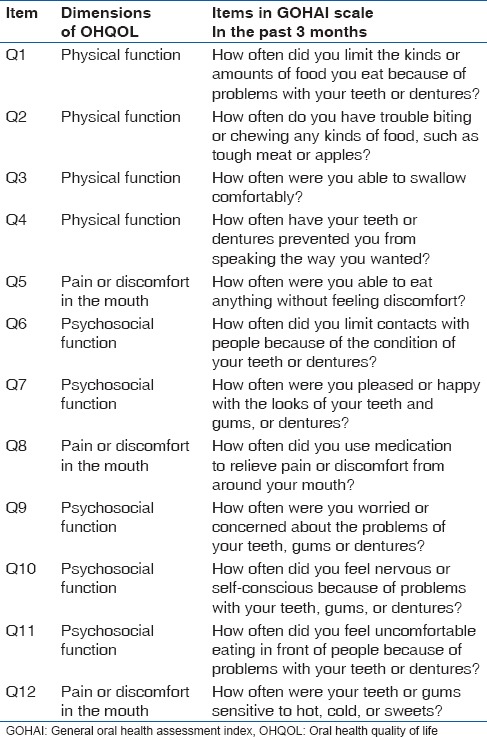
Translation process
GOHAI was translated by forward and backward blind translation process into Tamil language (target language). The translated Tamil version was field tested on 60 samples from the general population. The subjects were asked to read the questionnaire and give their feedback and the difficulties encountered were recorded. It was identified that subjects with lower level of education (school education incomplete or completed) needed more explanation for understanding questions 6, 7, 10, and 11. It was also seen that few of them erred with the choices for questions 3, 5, and 7 as they were reversely scored. In order for better clarity, we added relevant examples or situations for all the 12 questions. The questions 3, 5, and 7 were negatively rephrased and choices were retained similar to the other questions, that is, never had problem in swallowing - 5 score, always had problem in swallowing - 1 score. All the necessary changes were made, and final translated Tamil version was drafted.
Test-retest
Test-retest was done to establish the stability and reliability of the questionnaire. Sixty subjects 20–70 years of age who were able to read Tamil fluently and were not suffering from any acute dental problems were selected from the general population. The questionnaire was administered twice to the same subjects within an interval of 1-week.
Data collection
For the main study, convenience sampling was done, and 265 consecutive patients aged 20–70 years attending the out-patient department of the dental institution were recruited. Subjects were invited to participate in the study, and if they agreed, both verbal and written informed consent was taken. Subjects were included in the study only if they were native of Tamil Nadu with Tamil as their native language and able to read Tamil fluently. Those subjects suffering from acute and severe disease or infections, those diagnosed with dementia or psychological diseases and under therapy were excluded. Completely edentulous patients were also excluded.
Subjects were requested to fill a self-report questionnaire. It consisted of information on age, gender, education, employment status, income, frequency of tooth brushing, history of smoking, use of chewable tobacco, history of bad breath, presence of bleeding gums, burning mouth, history of previous visit to dentist, whether wearing denture for missing teeth, type of denture worn either Fixed Partial Denture (FPD) or Removable Partial Denture (RPD), self-perceived general health status, self-perceived oral health status, whether satisfied with oral health, self-perceived need for dental treatment, history of Temporomandibular Joint (TMJ) discomfort, self-perceived satisfaction with esthetics and presence of any medical problems. The GOHAI-Tml was attached with the history sheet. The authors were available at all times to clarify any queries.
Clinical examination was done by a single examiner on the same day when the questionnaire was administered using sterilized mouth mirror, UNC-15 probe, and dental explorer no. 23/17. The clinical parameters recorded were the number of teeth present, missing teeth, decayed teeth, restored teeth, crowned teeth, teeth with gingival recession, mobile teeth, presence of oral lesions and teeth with cervical abrasion. The oral hygiene status was assessed using Simplified Oral Hygiene Index (OHI-S).
Data entry and statistical analysis
All the 265 questionnaires were duly filled and returned with no incomplete responses. Among those recruited five subjects had received no formal education but were able to read Tamil, hence they were also included. IBM SPSS Statistics for Windows, Version 20.0 (IBM Corp., Armonk, NY, USA) was used for statistical analysis. Descriptive statistics was reported for all the variables assessed in the study. T-test or ANOVA was used to compare the means, that is, both mean ADD and mean SC-GOHAI and significance was reported as P values. If P < 0.05, Tukey's post-hoc was done for multiple comparisons within a categorized variable. For each of the 12 items percentage frequency was calculated for all the responses.
Reliability was analyzed using test-retest, Cronbach alpha, and split half reliability. Inter-item and item-total correlation were evaluated using Spearman rank correlation.
Construct validity is useful in understanding the score when no adequate criterion measure exists or when content validation cannot be relied. It can be assessed by studying the relationship between GOHAI and other variables that the measure would be expected to relate to if it measured the construct it was intended to assess.[4] It was hypothesized that respondents of younger age group, higher income and education, those following good oral hygiene practices would have higher or better GOHAI score. Concurrent validity was measured by assessing the relationship between GOHAI scores and self-perceived oral health, general health, satisfaction with oral health, bad breath, bleeding gums, burning mouth, TMJ discomfort, need for dental treatment, and esthetic satisfaction. It was hypothesized that subjects reporting poor oral or general health, dissatisfied with their oral health, having oral health problems, feeling the need to undergo dental treatment and those dissatisfied with the appearance of their teeth or denture were most likely to have low GOHAI scores.
Discriminant validity was evaluated by comparing the GOHAI scores with the objectively assessed clinical parameters. It was hypothesized that lesser the number of missing teeth, decayed teeth, mobile teeth, gingival recession, and cervical abrasion better will be the GOHAI score. Modest correlation was also expected between the GOHAI score and the number of restored teeth, crowned teeth and OHI-S score.
Exploratory factor analysis was done to examine the factor structure and internal reliability. To determine the adequacy of the strength of factor analysis, Kaiser-Meyer-Olkin measure of sampling adequacy and Barlett's test of sphericity was done. Using principal component analysis, the factors were extracted using Eigenvalue technique. After factor extraction, rotation was done by varimax orthogonal rotation and rotated component matrix derived.
Results
Participants characteristics and responses to general oral health assessment index-Tml
Mean ADD-GOHAI was 52.7 (6.8, range 22–60, median 54). Mean SC-GOHAI was 2 (2.4, range 0–11, median 1). The mean age of the study population was 31 years (11.6). It was seen that among the 265 subjects 64% (169/265) were men, and 36% (96/265) were women. Almost 63% (167/265) of the study population was aged less than 30 years. Observation of the brushing habits showed that 68% (179/265) of the participants brushed at least once daily (only two respondents reported that they brushed few times in a week and all the subjects had the habit of brushing their teeth at different frequencies hence for test of significance only two groups were considered refer Table 2). Among those recruited 14.3% (38/265) of them smoked and 61.5% (163/265) had visited dentist before. Only 8% (22/265) subjects reported replacing their teeth with dentures and among them 17 of them had replaced with FPD and 5 with RPD [Table 2].
Table 2.
Construct validity and descriptive statistics of the variables assessed in the study
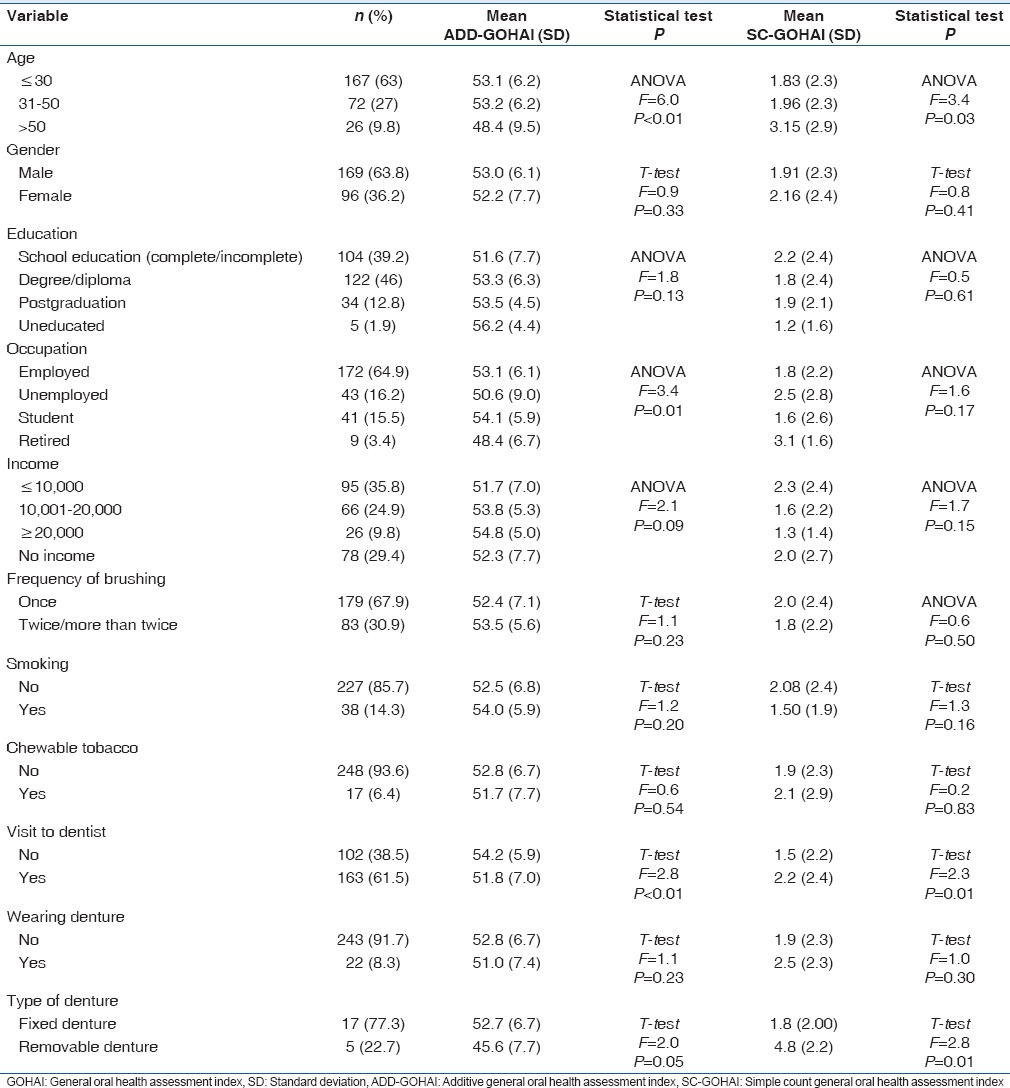
The mean, standard deviation and median of the 12 items in the GOHAI scale are given in Table 3. Among the items analyzed it was seen that negative scores (always, fairly often and sometimes) were more commonly reported for Q2-24.2% (64/265), Q7-29.4% (78/265) and “Q9-30.9% (82/265). The mean values ranged from 3.8 to 4.2 [Table 3]. Responses like seldom or never (less impact) were more frequently reported for items such as Q3-92.8% (246/265), Q4-94.4% (250/265), Q8-92.8% (246/265) and Q11-90.9% (241/265). The mean values ranged from 4.7 to 4.8 [Table 3].
Table 3.
Descriptive statistics of the GOHAI scale and the frequency distribution of the responses for each item
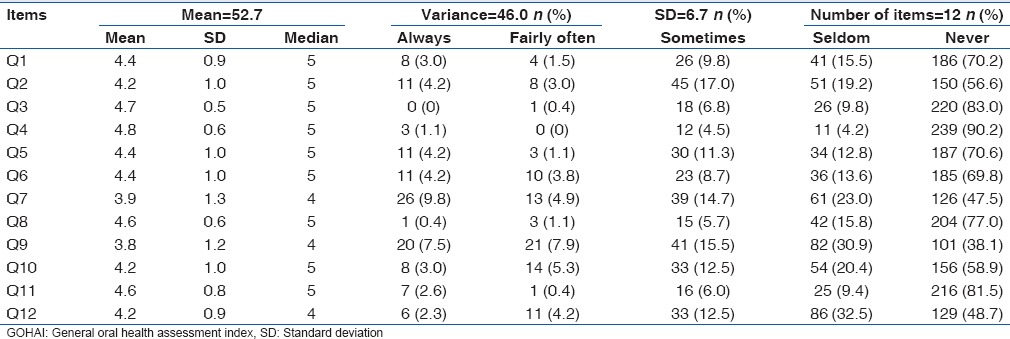
Validity
Face and content validity of the translated version was established by administering the Tamil questionnaire to 60 volunteers prior to test-retest procedure. Interview session along with the authors and professional translators' ensued and necessary changes were made.
The construct validity was supported as hypothesized for the following variables in this population. OHRQOL decreased with increasing age, with subjects aged more than 50 years reporting poorer OHQOL and more number of negative responses. Statistically significant difference was seen in both the mean ADD and SC-GOHAI scores between age groups (P < 0.01, P = 0.03 respectively). Unemployed and retired respondents perceived poorer OHRQOL. Mean ADD-GOHAI score showed a statistically significant difference within the group based on their occupation (P = 0.01). Subjects who replaced missing teeth with RPDs reported more number of negative responses (i.e. mean higher SC-GOHAI) and statistically significant difference was seen when comparing with those wearing FPDs (P = 0.01 ) [Table 2]. Contrary to the hypothesis, it was observed that participants who had never visited a dentist reported better OHQOL and statistically significant difference was seen in both the mean ADD and SC-GOHAI scores based on their history of visit (P < 0.01, P = 0.01respectively). No significant difference was seen in OHRQOL between those wearing denture and those not wearing denture (P = 0.30) [Table 2].
The results for concurrent validity were in agreement with the hypothesis, and statistical significance was seen (P < 0.001to 0.02) [Table 4]. Analysis of discriminant validity showed that lower mean ADD-GOHAI score was seen in patients with more number of missing teeth, decayed teeth, gingival recession, mobility due to periodontal disease, crowned teeth and filled teeth [Table 5]. Patients with poor oral hygiene status and those diagnosed with localized or generalized periodontitis had lower ADD-GOHAI scores. Statistically significant difference was seen in the mean GOHAI scores (both ADD-GOHAI, SC-GOHAI) for clinical parameters like number of teeth present, decayed teeth, gingival recession, mobility and between patients diagnosed with generalized periodontitis and gingivitis (P < 0.001 to 0.04). With respect to number of filled teeth statistical significant difference was seen only for mean SC-GOHAI score (P = 0.04) [Table 5].
Table 4.
Concurrent validity of GOHAI scores
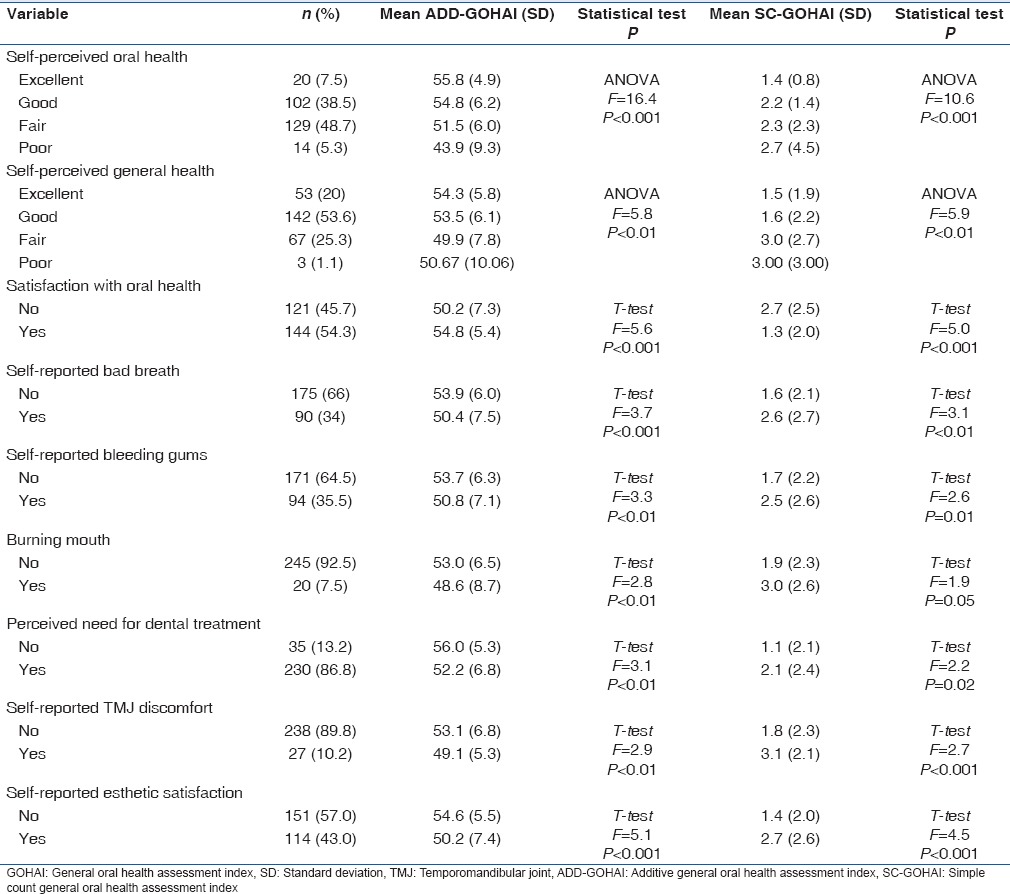
Table 5.
Discriminant validity for GOHAI scores
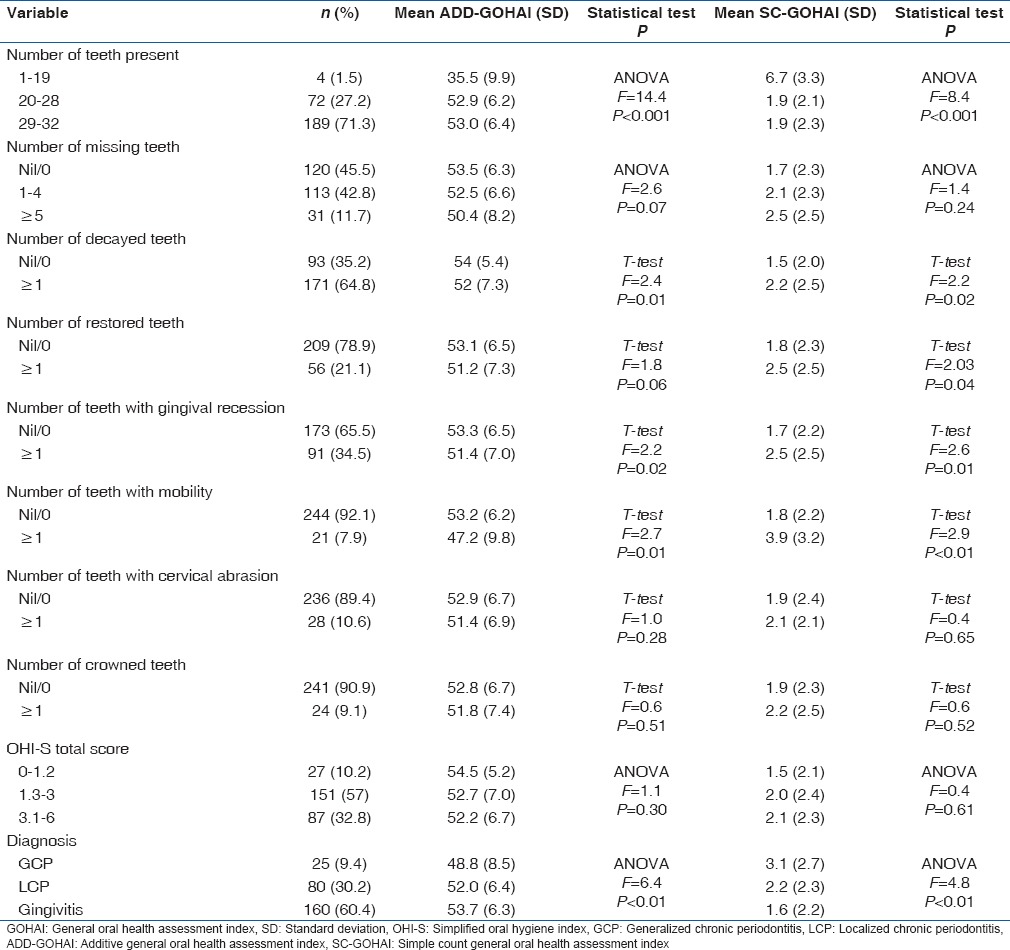
Factor analysis
Principal component analysis was used for factor extraction. Only factors with eigenvalues >xs1 were extracted (Kaisers criteria) which resulted in extraction of the first four factors. It was seen that the first factor accounted for 35% (35/100) variance, second 14.2% (14.2/100) variance, third 8.7% (8.7/100) variance, and fourth 8.3% (8.3/100) variance. All the four factors together accounted for 66.4% (7.9/12 ) variance.
Following factor extraction, factor rotation was done and rotated component matrix derived [Table 6]. Varimax orthogonal rotation with Kaiser normalization was used. It was seen that Q6, Q7, Q9, and Q10 clustered under first factor; Q1, Q2, and Q5 clustered under second factor; Q3, Q4, and Q11 clustered under third factor and Q8, Q12 clustered under fourth factor. Based on the clustering of items, we can label the first factor as psychosocial effect of oral health, second factor as physical effect affecting primarily eating ability, third factor as physical effect affecting speaking, swallowing, and also psychosocial effect of uncomfortable eating in front of others and fourth factor encompasses pain or discomfort due to dental problems. It was seen that the communalities for all variables were above 0.50 hence we did not exclude any variables on the basis of low communalities.
Table 6.
Rotated component matrix
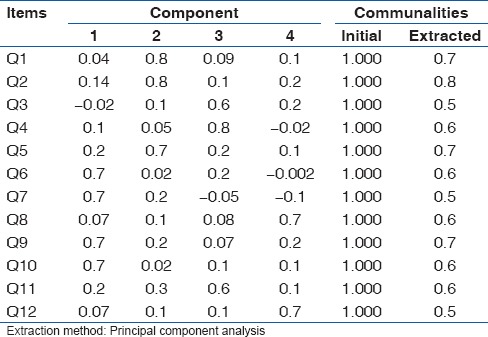
Reliability
GOHAI-Tml was administered to 60 subjects twice within a period of 1-week. Among the 60 subjects, 30 subjects were of lower educational level (incomplete or completed school education, uneducated but able to read Tamil), and the other 30 were of higher educational level (degree/diploma/postgraduation). The Spearman rank correlation ranged from 0.8 to 0.9, P < 0.001 for all the 12 items between visits for the 60 samples. Cronbach alpha was 0.9, indicating excellent and high internal consistency. There was high correlation between ADD-GOHAI and SC-GOHAI between visit 0.9 (P < 0.001 ) and 0.9 (P < 0.001), respectively (statistics not shown in table).
Reliability analysis among the 30 subjects who were less educated showed that Spearman rank correlation between visits ranged from 0.8 to 1.00, P < 0.001 for all the 12 items and Cronbach alpha was 0.8, indicating good internal consistency. The ADD-GOHAI and SC-GOHAI showed a very high correlation between visits 0.9 (P < 0.001 ) and 0.9 (P < 0.001) respectively (statistic not shown in table).
Reliability analysis among the subjects of higher education showed that Spearman rank correlation between visits ranged from 0.7 to 0.9, P < 0.001 for all the 12 items and Cronbach alpha was 0.9, indicating excellent internal consistency. The ADD-GOHAI and SC-GOHAI showed a very high correlation between visits 0.9 (P < 0.001) and 0.7 (P < 0.001), respectively (statistic not shown in table).
The Cronbach alpha for 265 samples was 0.8 suggesting good internal consistency. The inter-item correlation between the 12 items in the questionnaire was positive. The strength of correlation between few items such as “Q6 and Q1, Q3, Q8” and “Q7 and Q3, Q8, Q12” was poor and ranged from 0.01 to 0.09. Item scale correlation ranged from 0.3 to 0.7 (P < 0.001). Corrected item-scale correlation ranged from 0.3 to 0.6 and items 3, 4, 7, 8, and 12 showed an acceptable but weak positive relationship with total score (acceptable corrected item-total correlation (r) 0.3–0.7, Ferketich 1991).[21] The removal of these items did not significantly affect Cronbach alpha, hence we considered retaining these items. The item scale statistics showed that deletion of items 2, 5, and 9 would result in a slightly lower Cronbach alpha value and in turn affect the reliability of the scale.
Split half reliability was evaluated, the scale was divided into two equal parts (q1–q6 one half, q7–q12 other half) consisting of 6 items each and Cronbach alpha was determined, the correlation between the halves was 0.6 and Spearman brown coefficient was 0.7. Guttman split half coefficient was found to be 0.7 (statistic not shown in table).
Discussion
Tamil is the language of Tamilians all over the world, and it has been granted classical status. Modern Tamil language is described as diglossic, meaning that it exhibits a division between the colloquial spoken form of the language and the written language used for formal purposes. Spoken Tamil has evolved significantly over years, the colloquial versions are so varied that differences exist within the state due to its rich cultural, religious, social and geographical diversity. The translated version was drafted keeping in mind all such difference so that it will be acceptable and understandable to all. In order to evaluate the effect of oral health on the QOL in this population and due to unavailability of a validated Tamil OHQOL questionnaire for research purpose we aimed to develop GOHAI-Tml version. The present study is the first to adapt this scale for evaluating the OHRQOL among the Tamil speaking population.
The current study established the psychometric properties of GOHAI-Tml version. It was found to be reliable and valid. The positively phrased items (Q3, Q5, Q7) were negatively rephrased in this Tamil version similar to the Maltese, Chinese, and Romanian translation of the questionnaire.[9,18,22] The translated Tamil version was highly consistent irrespective of the educational status of the respondents. The Cronbach alpha for internal consistency was found to be higher than the other translated versions like Hindi 0.79, Spanish 0.77, Persian 0.78, Portuguese 0.76, Malay 0.79, and Romanian 0.63.[8,13,15,17,20,22] Deletion of any of the items did not seem to increase the Cronbach alpha value hence retaining all the items is justifiable for the GOHAI-Tml version.
The item scale correlation ranged from 0.3 to 0.7; it was evident that the items trouble swallowing, trouble speaking the way you wanted, use of medications to relieve pain or discomfort and teeth or gums sensitive to hot cold or sweet had a weaker but acceptable correlation with the ADD-GOHAI score. Similar to this study the French, Malay, Persian translations showed lower item scale rating for the Q3, the likely reason for such a finding in this study could be probably due to dominance of younger individuals, the item was originally included in the scale to measure the oral impact in people with xerostomia.[10,13,17] The Inter-item correlation showed a very weak relationship between items such as limiting the kind of food, trouble swallowing, limit contact with people, pleased with look of teeth, medicines to relieve pain and sensitive to hot or cold food.
Test-retest Spearman rank correlations between visits were very strong (P < 0.001) indicating high reliability. Mean ADD-GOHAI was higher when compared with that of other versions indicating comparatively minimal impact on QOL due to oral health status. The summative GOHAI score was similar to the German version (mean ADD-GOHAI score 53).[14]
The means of the individual items in the scale ranged from 3.8 to 4.7, people felt more impact on satisfaction with look of teeth/denture and worrying about teeth/gums/dentures than the other items in the scale. Based on the higher percentage of negative responses to individual items, it can be concluded that major impact was on biting or chewing, satisfaction with appearance of teeth and worrying about teeth, gums or dentures. The least impact was on speaking (5.6%), followed by swallowing (7.2%) and uncomfortable eating in front of others (9%).
Concurrent and discriminant validity was established as hypothesized. Our study showed good correlation between GOHAI score and clinical parameters and self-reported oral health problems. It was surprisingly observed that subjects who had never visited a dentist had reported better OHRQOL, indicating that irrespective of the clinical status self-perception of one's own health plays an important role in seeking professional help.
Factor extraction using principle component analysis resulted in extraction of four factors with eigenvalue more than 1 accounting for 66.4% of variance, this was in contrast to the original factor structure of the index as proposed by Atchison and Dolan and the translated Arabic, Spanish and Malay GOHAI versions.[4,8,11,17] The Portuguese version showed three distinct factors and the Swedish version indicated two-factor solutions.[15,16] In the GOHAI-Tml version, the fourth factor was formed by clustering of items that were least affected due to oral health problems (Q3, Q4, and Q11) and these items also showed a weak positive correlation with total score of the scale.
Limitations of the study are convenience sampling, cross-sectional design, and the subjects were recruited from clinical setting, hence the study subject may not be representative of the population, moreover the study sample were predominantly of younger age hence impact on OHRQOL identified in this research work could be more expressive of that age group, hence furthermore scientific work with subjects from diverse age group should be carried out. Very few subjects were wearing denture in this sample hence supplementary studies with more denture users is needed to elicit the impact on QOL. Additional studies are needed to evaluate whether GOHAI-Tml can be used as an effective tool to monitor dental treatment outcomes.
Conclusion
Within the limitations of the study, it can be concluded that GOHAI-Tml has shown acceptable psychometric properties, so it could be used as an efficient tool in identifying the impact of oral health on QOL among the Tamil speaking population.
Financial support and sponsorship
Nil.
Conflicts of interest
There are no conflicts of interest.
Acknowledgement
The research project was self-funded by the author and co-authors.
References
- 1.DHHS. Oral Health in America: A Report of the Surgeon General. Rockville, Maryland: US Department of Health and Human Services, National Institute of Dental and Craniofacial Research, National Institute of Health; 2000. p. 7. [Google Scholar]
- 2.Locker D. Measuring oral health: A conceptual framework. Community Dent Health. 1988;5:3–18. [PubMed] [Google Scholar]
- 3.Inglehart MR, Bagramian RA. Oral Health-related Quality of Life. Illinois: Quintessence Publishing Co., Inc.; 2002. [Google Scholar]
- 4.Atchison KA, Dolan TA. Development of the geriatric oral health assessment index. J Dent Educ. 1990;54:680–7. [PubMed] [Google Scholar]
- 5.Strauss RP, Hunt RJ. Understanding the value of teeth to older adults: Influences on the quality of life. J Am Dent Assoc. 1993;124:105–10. doi: 10.14219/jada.archive.1993.0019. [DOI] [PubMed] [Google Scholar]
- 6.Slade GD, Spencer AJ. Development and evaluation of the oral health impact profile. Community Dent Health. 1994;11:3–11. [PubMed] [Google Scholar]
- 7.Leao A, Sheiham A. The development of a socio-dental measure of dental impacts on daily living. Community Dent Health. 1996;13:22–6. [PubMed] [Google Scholar]
- 8.Sánchez-García S, Heredia-Ponce E, Juárez-Cedillo T, Gallegos-Carrillo K, Espinel-Bermúdez C, de la Fuente-Hernández J, et al. Psychometric properties of the general oral health assessment index (GOHAI) and dental status of an elderly Mexican population. J Public Health Dent. 2010;70:300–7. doi: 10.1111/j.1752-7325.2010.00187.x. [DOI] [PubMed] [Google Scholar]
- 9.Wong MC, Liu JK, Lo EC. Translation and validation of the Chinese version of GOHAI. J Public Health Dent. 2002;62:78–83. doi: 10.1111/j.1752-7325.2002.tb03426.x. [DOI] [PubMed] [Google Scholar]
- 10.Tubert-Jeannin S, Riordan PJ, Morel-Papernot A, Porcheray S, Saby-Collet S. Validation of an oral health quality of life index (GOHAI) in France. Community Dent Oral Epidemiol. 2003;31:275–84. doi: 10.1034/j.1600-0528.2003.t01-1-00006.x. [DOI] [PubMed] [Google Scholar]
- 11.Atieh MA. Arabic version of the geriatric oral health assessment index. Gerodontology. 2008;25:34–41. doi: 10.1111/j.1741-2358.2007.00195.x. [DOI] [PubMed] [Google Scholar]
- 12.Daradkeh S, Khader YS. Translation and validation of the Arabic version of the geriatric oral health assessment index (GOHAI) J Oral Sci. 2008;50:453–9. doi: 10.2334/josnusd.50.453. [DOI] [PubMed] [Google Scholar]
- 13.Motallebnejad M, Mottaghi K, Mehdizade S, Alaedini F, Bijani A. Reliability and validity of the Persian version of the general oral health assessment index (GOHAI) Caspian J Dent Res. 2012;2013(1):8–17. [Google Scholar]
- 14.Hassel AJ, Rolko C, Koke U, Leisen J, Rammelsberg P. A German version of the GOHAI. Community Dent Oral Epidemiol. 2008;36:34–42. doi: 10.1111/j.1600-0528.2007.00351.x. [DOI] [PubMed] [Google Scholar]
- 15.Carvalho C, Manso AC, Escoval A, Salvado F, Nunes C. Translation and validation of the Portuguese version of the geriatric oral health assessment index (GOHAI) Rev Port Saude Publica. 2013;31:166–72. [Google Scholar]
- 16.Hägglin C, Berggren U, Lundgren J. A Swedish version of the GOHAI index. Psychometric properties and validation. Swed Dent J. 2005;29:113–24. [PubMed] [Google Scholar]
- 17.Othman WN, Muttalib KA, Bakri R, Doss JG, Jaafar N, Salleh NC, et al. Validation of the geriatric oral health assessment index (GOHAI) in the Malay language. J Public Health Dent. 2006;66:199–204. doi: 10.1111/j.1752-7325.2006.tb02580.x. [DOI] [PubMed] [Google Scholar]
- 18.Santucci D, Camilleri L, Kobayashi Y, Attard N. Development of a Maltese version of oral health-associated questionnaires: OHIP-14, GOHAI, and the denture satisfaction questionnaire. Int J Prosthodont. 2014;27:44–9. doi: 10.11607/ijp.3603. [DOI] [PubMed] [Google Scholar]
- 19.Naito M, Suzukamo Y, Nakayama T, Hamajima N, Fukuhara S. Linguistic adaptation and validation of the general oral health assessment index (GOHAI) in an elderly Japanese population. J Public Health Dent. 2006;66:273–5. doi: 10.1111/j.1752-7325.2006.tb04081.x. [DOI] [PubMed] [Google Scholar]
- 20.Mathur VP, Jain V, Pillai RS, Kalra S. Translation and validation of Hindi version of geriatric oral health assessment index. Gerodontology. 2013;11:16. doi: 10.1111/ger.12099. [DOI] [PubMed] [Google Scholar]
- 21.Ferketich S. Focus on psychometrics. Aspects of item analysis. Res Nurs Health. 1991;14:165–8. doi: 10.1002/nur.4770140211. [DOI] [PubMed] [Google Scholar]
- 22.Murariu A, Hanganu C, Bobu L. Evaluation of the reliability of the geriatric oral health assessment index (GOHAI) in institutionalized elderly in Romania: A pilot study. OHDMBSC. 2010;9:11–5. [Google Scholar]


